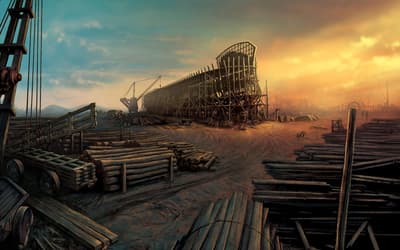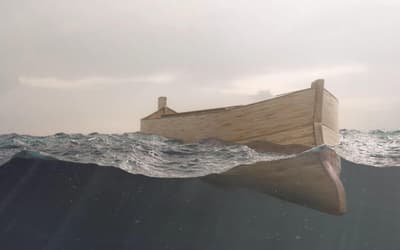Research conducted by Answers in Genesis staff scientists or sponsored by Answers in Genesis is funded solely by supporters’ donations.
Abstract
I present three problems with Hugh Ross’ local flood model. First, it was not possible to sustain Ross’ proposed height of local flood water in Mesopotamia, because the water would have efficiently and rapidly drained through the Persian Gulf and Strait of Hormuz into the Indian Ocean. Second, the current of this draining water would have carried the Ark far from Mesopotamia, making it impossible for the Ark to have landed in northern Mesopotamia as Ross maintains. Third, at its greatest extent, the water level in Ross’ local flood model falls far lower than the elevation of the location that Ross says the Ark landed. These difficulties render Ross’ local flood model physically impossible. This is in addition to numerous biblical issues.
Keywords: Hugh Ross, local flood
Introduction
Hugh Ross is a prominent advocate of progressive creation, day age, and a local flood. Others have critiqued Ross’ flood model from a biblical perspective (Chaffey and Lisle 2008, pp. 81–106; Van Bebber and Taylor 1995, pp. 55–59). For that matter, more than a half century ago Whitcomb and Morris (1961) provided an exhaustive refutation of the local flood model. It is not my intention to review the biblical difficulties with the local flood model here. However, few, if any, have pointed out serious physical problems with Ross’ local flood model. In his recent book on Genesis (Ross 2014) Ross discussed his local flood model in more detail than he had previously, so now is an opportune time to examine his flood model for its physical shortcomings.
Ross insists that the Flood was local on several grounds. A major physical argument that Ross makes for a local flood is that there is not enough water on the earth to cover the highest mountains, such as Mount Everest, as they now exist. Of course, this ignores the tectonic upheaval that global Flood models generally invoke (Snelling 2009b), and virtually no advocates of the global Flood think that many mountains that now exist existed prior to the Flood (Whitcomb and Morris 1961, pp. 77, 268). Ross accepts the idea that the earth is 4.6 billion years old and has undergone gradual changes, so he chooses to interpret much of the earth’s surface in terms of that belief (uniformitarianism). Rather than a global Flood, Ross argues that all men were confined to Mesopotamia prior to the Flood, so a flood that affected only Mesopotamia would have sufficed to wipe out all of humanity not in the Ark. The local flood has been thoroughly refuted (Whitcomb and Morris; Snelling 2009a, pp. 15–122), but, how does Ross’ model stand up to physical scrutiny? It does not stand up well, as I shall describe three serious problems for Ross’ local flood model.
Difficulty 1
The Ross model includes no physical barrier to impound the water necessary to flood Mesopotamia
Genesis 7:19 tells us that,
And the waters prevailed exceedingly upon the earth; and all the high hills, that were under the whole heaven, were covered.
Of course, since Ross does not believe that the Flood was global, he does not believe that all of the hills and mountains of the earth were covered at the time of the Flood. Ross (2014, p. 150) explains Genesis 7:19 as follows:
Genesis 7:19 describes Noah’s inability to see anything but water, horizon to horizon, from his viewpoint on the ark’s upper deck. If the ark were floating anywhere near the middle of the Persian Gulf or the vast Mesopotamian plains on water as much as two or three hundred feet deep, no hills or mountains would be visible from his position.
A plain by definition lacks hills. If the Mesopotamia plains were covered with a two or three hundred feet of water, then it is questionable if any significant hills were covered by the Flood, rendering Genesis 7:19 almost meaningless.
Ross used a figure to illustrate the extent of his local flood model. Figure 17.1 (2014, p. 158) has three versions of the same satellite image. The unedited version shows the modern day Arabian Peninsula (fig. 1). A second version shows sea level around the Arabian Peninsula during the Ice Age (fig. 2). In this version, the Red Sea and the Persian Gulf are dry land. The third version shows Ross’s estimate of the extent of water of the Flood (fig. 3). Ross thinks that the Flood happened during the Ice Age, and that the Flood was restricted to the region of Mesopotamia. Hence, his flood model shows the Red Sea dry, but the Persian Gulf is filled, and then some, because the waters of Mesopotamia flow into the Persian Gulf. Sea level during the Ice Age was several hundred feet lower than today, with sea level at any particular time dependent upon the amount of water locked up in glaciers. While both the Red Sea and the Persian Gulf today are much deeper than a few hundred feet, their connections to the Indian Ocean (the Mandeb Strait and Gulf of Aden for the Red Sea and the Strait of Hormuz for the Persian Gulf) are relatively shallow. However, today there is a path that is no shallower than 250 ft (76.2 m) through the Strait of Hormuz. The path through the Mandeb Strait and the Gulf of Aden has a similar minimum depth. Hence, if the Persian Gulf and Red Sea mostly were dry at the beginning of the Flood as in Ross’ model, then the Flood must have happened when sea level was at least 250 ft (76.2 m) lower than today.

Fig. 1. Satellite image of the Arabian Peninsula showing the current sea levels. Credit: NASA and Wikipedia commons.

Fig. 2. The probable landmasses around Arabia just prior to the Genesis Flood, according to the Ross flood model. With ice still covering much of North America, Siberia, and Europe, global sea levels would have been lower, leaving most of what is now the Persian Gulf and Red Sea as dry land.

Fig. 3. The probable extent of Noah’s Flood at its peak, a little over 300,000 mi2 (777,000 km2), according to the Ross flood model.
From Ross’ image showing the extent of the Flood in his model, the water primarily is confined to portions of Mesopotamia, part of the Arabian Peninsula, and the Persian Gulf. It is important to note that the Persian Gulf is connected to the Indian Ocean through the Strait of Hormuz in Ross’ image. While the resolution of this image is low, it is possible to estimate from landmarks on the image the extent of Ross’ proposed flood on modern maps. From this, one can see that in Ross’ estimate, the Flood reached as far north as modern day Tikrit, at an elevation of about 320 ft (97.5 m) above current sea level, but not as far as Baiji, approximately 360 ft (109.7 m) above sea level.1 Hence, in Ross’ model the floodwaters rose to more than 320 ft (97.5 m) but probably less than 350 ft (106.6 m) above current sea level. This is consistent with Ross’ statement quoted above where he suggested that the flood was “as much as two or three hundred feet [60.9–91.4 m] deep.” Assuming that sea level then was at least 250 ft (76.2 m) lower than today, the waters of the flood in Ross’ model must have risen to nearly 600 ft (182.8 m) above sea level at that time. These waters connected to the Indian Ocean through the Strait of Hormuz, so how could the water have piled up in Mesopotamia nearly 600 ft (182.8 m) higher than the sea level of that time? The Strait of Hormuz is slightly wider than 20 mi (32.1 km) at its narrowest point today, but with water level in the Persian Gulf nearly 350 ft (106.6 m) higher than today’s sea level, the Strait of Hormuz would have been even wider then. Given the depth and width of the Strait of Hormuz, it would have been impossible for the water to have been impounded to a depth of 20 ft (6 m) across the Mesopotamian plain, let alone a depth of nearly 600 ft (182.8 m). A local flood of any appreciable depth would have required a considerable physical barrier at the Strait of Hormuz. This is a major problem for Ross’ model. Absent such a barrier, Ross’ so-called model is no model at all.
Difficulty 2
Lack of drift of the Ark
Laying aside for now the first difficulty, there is a second problem for Ross model. In addressing the statement of Genesis 7:19 that “all the high hills under the whole heaven were covered,” recall that Ross (2014, p. 150) wrote,
If the ark were floating anywhere near the middle of the Persian Gulf or the vast Mesopotamian plains on water as much as two or three hundred feet deep, no hills or mountains would be visible from his position.
Ross does not state when he thinks that the Genesis 7:19 statement that all the high hills were covered applied. Assuming that the events of Genesis 7 largely are sequential, it could have been after the 40 days and nights of rain (Genesis 7:12, 17). However, it is likely that Genesis 7:19 is introductory encapsulation. If so, then Genesis 7:19 serves to describe an occurrence achieved during the first 40 days of the cataclysm. At any rate, the high hills being covered must be no later than the 150 day mark of the Flood (Genesis 7:24; 8:3). Ross believes that Noah began his voyage in Mesopotamia, but given the large height of water above sea level in Ross’ model, there must have been a tremendous current transporting water off of Mesopotamia, down the Persian Gulf, and out into the Indian Ocean. Why was the Ark not carried along by this current? One would expect that by 40 days into the Flood the Ark would have been transported far south and east from its point of origin.
Difficulty 3
The location of where the Ark came to rest
The third difficulty with Ross’ local flood model is his location of the grounding of the Ark. Genesis 8:4 records that the Ark rested on the mountains of Ararat five months into the Flood. The exact location of the mountains of Ararat is not clear, though they generally were north of the portion of the world where Old Testament events took place. The region certainly would include the mountain with the modern name of Ararat in Turkey, but it also includes mountainous regions farther south. Ross claims that the mountains of Ararat could even include foothills in northern Iraq. Ross (2014, pp. 179–180) suggests that the likely place that the Ark landed was
. . . the Ararat hills just a few hundred feet above sea level some 20 to 50 miles [35 to 80 km] north of Nineveh’s ruins.
In his Figure 18, Ross (2014, p. 181) even included a map (fig. 4). The map has a large circle showing the region that he thinks is the mountains of Ararat, along with a bull’s eye showing his estimate of the most probable location of where the Ark landed and a dot on the ruins of Nineveh. The Zagros Mountains lie to the north of Nineveh with foothills extending downward toward Nineveh, but, apparently, Ross never checked the accuracy of this location being “a few hundred feet above sea level.” The Nineveh site is across the Tigris River from modern day Mosul. The airport at Mosul is at about of 700 ft (213.3 m) above sea level today. The ruins of Nineveh average about 750 ft (228.6 m) above sea level. In contrast, Baghdad, which lies much farther south in the plains of Mesopotamia, is little more than 100 ft (30.4 m) above sea level. Obviously, in Ross’ model the location of Baghdad was covered during the Flood, but not Nineveh. Even worse, 20 mi (32.1 km) north of Nineveh the altitude is about 1400 ft (426.7 m) above sea level. However, the area just 20 mi (32.1 km) north of Nineveh is not particularly hilly—there are many plots of farmland on fairly flat terrain though with a low angle slope upward toward the mountains to the north. Proceeding northward, the elevation increases, but the land does not become hilly until an altitude of nearly 2000 ft (609.6 m). North of there the land is hilly—most of the land is at least 2000 ft (609.6 m) above sea level, but with many areas far higher. Thus, Ross’ claim that the hills “some 20 to 50 miles [32.1–80.4 km] north of Nineveh’s ruins” are “just a few hundred feet above sea level” is patently false.

Fig. 4. Possible location of the Ark’s resting place, according to the Ross flood model. The shaded area is the region identified in Genesis 8:4 as the “mountains of Ararat.” Red dot shows the likely landing location for Noah’s Ark. Black dot indicates where the ruins of the ancient city of Nineveh have been found. Credit for terrain image: Google Earth.
Suppose that the Ark landed in some slightly hilly area at an altitude of only 1500 ft (457.2 m) above today’s sea level. How could a flood whose waters rose to at best only 350 ft (106.6 m) above today’s sea level have delivered the Ark there? For that matter, how could the flood have delivered the Ark to the location of Nineveh (located in Mesopotamia), more than twice the altitude of the waters in Ross’ local flood model? The simple answer is that it could not. In Ross’ model, the floodwaters did not extend beyond the lower plains of Mesopotamia and certainly did not extend to the region that he claims contains the mountains of Ararat. In other words, there are not even hills within the extent of his local flood model that might qualify as the mountains of Ararat.
Conclusion
For some time, Hugh Ross has criticized the concept of a global Flood, both on supposed biblical grounds, but especially on supposed physical and scientific grounds. Many of his physical objections to a global Flood depend upon misrepresentation of the global Flood model (such as Mt. Everest existing prior to the Flood), but also upon the assumptions of uniformitarianism. Here I have briefly evaluated physical problems with Ross’ own local flood model. These objections are based not upon assumptions about past processes (uniformitarianism as opposed to catastrophism) but rather upon observations and scientific principles in the here and now (things such as elevations and the behavior of water to flow downhill). These difficulties present fatal challenges to Ross’ local flood model and demonstrate that his model as it now exists is entirely indefensible. Ross conceivably could amend his model by postulating that during the flood, water levels around the world rose at least 1500 ft (457.2 m) above today’s current sea level, but that proposal would suffer from many of the problems that he claims the global Flood does. Furthermore, since such a level could not have been confined to Mesopotamia, this would amount to a global Flood of sorts.
References
Chaffey, T., and J. Lisle. 2008. Old Earth Creationism on Trial. Green Forest, Arkansas: Master Books.
Ross, H. 2014. Navigating Genesis: A scientist’s journey through Genesis 1–11. Covina, California: RTB Press.
Snelling, A. A. 2009a. Earth’s Catastrophic Past: Geology, Creation, and the Flood. Vol. 1. Dallas, Texas: Institute for Creation Research.
Snelling, A. A. 2009b. Earth’s Catastrophic Past: Geology, Creation, and the Flood. Vol. 2. Dallas, Texas: Institute for Creation Research.
Van Bebber, M., and P. S. Taylor. 1995. Creation and Time: A Report on the Progressive Creationist Book by Hugh Ross. 2nd ed. Gilbert, Arizona: Eden Communications.
Whitcomb, J. C., and H. M. Morris. 1961. The Genesis Flood: The biblical record and its scientific implications. Phillipsburg, New Jersey: Presbyterian and Reformed Publishing.

















